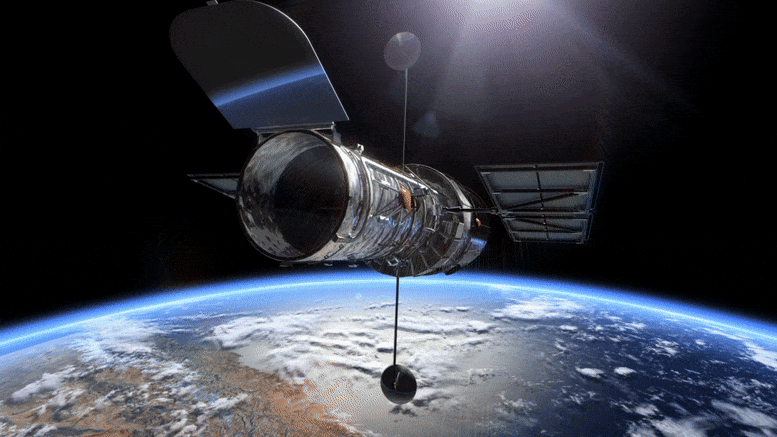
Die NASA und SpaceX untersuchen den Neustart des Orbitalteleskops von Hubble, um seine Betriebsdauer um Jahre zu verlängern

3D-Animation, die das Hubble-Weltraumteleskop über der Erde zeigt. Bildnachweis: ESA/Hubble (M. Kornmesser & LL Christensen)
Donnerstag, 22.09[{“ attribute=““>NASA and SpaceX signed an unfunded Space Act Agreement to study the feasibility of a SpaceX and Polaris Program idea to boost the agency’s Hubble Space Telescope into a higher orbit with the Dragon spacecraft, at no cost to the U.S. government.
There are currently no plans for NASA to conduct or fund a servicing mission or compete this opportunity. Rather, this study is designed to help the agency understand the commercial possibilities.
SpaceX – in partnership with the Polaris Program – proposed this study to gain understanding of the technical challenges associated with servicing missions. Other companies may propose similar studies with different rockets or spacecraft as their model, as this study is non-exclusive.

This image from April 24, 2021, shows the SpaceX Crew Dragon Endeavour as it approached the International Space Station. Credit: NASA
Teams anticipate that the study will take up to six months, collecting technical data from both Hubble and the SpaceX Dragon spacecraft. This data will be used to help determine whether it would be possible to safely rendezvous, dock, and move the aging telescope into a more stable orbit.
“This study is an exciting example of the innovative approaches NASA is exploring through private-public partnerships,” said Thomas Zurbuchen. He is the associate administrator for the Science Mission Directorate at NASA Headquarters in Washington. “As our fleet grows, we want to explore a wide range of opportunities to support the most robust, superlative science missions possible.”
Although Hubble and Dragon will serve as test models for this study, portions of the mission concept may be applicable to other spacecraft, particularly satellites in near-Earth orbit like Hubble.

An astronaut aboard the space shuttle Atlantis captured this image of the Hubble Space Telescope on May 19, 2009. Credit: NASA
Hubble has been operating since 1990, deployed approximately 335 miles above Earth in an orbit that is slowly decaying over time. Reboosting Hubble into a higher, more stable orbit could add multiple years of operations to its life. It has been reboosted several times during servicing missions.
At the end of its lifetime, NASA plans to safely de-orbit or dispose of Hubble.
“SpaceX and the Polaris Program want to expand the boundaries of current technology and explore how commercial partnerships can creatively solve challenging, complex problems,” said Jessica Jensen. She is vice president of Customer Operations & Integration at SpaceX. “Missions such as servicing Hubble would help us expand space capabilities to ultimately help all of us achieve our goals of becoming a space-faring, multiplanetary civilization.”
The Hubble Space Telescope is a project of international cooperation between NASA and ESA (European Space Agency). NASA’s Goddard Space Flight Center in Greenbelt, Maryland, manages the telescope. The Space Telescope Science Institute (STScI) in Baltimore, Maryland, conducts Hubble science operations. STScI is operated for NASA by the Association of Universities for Research in Astronomy in Washington.

„Böser Kaffee-Nerd. Analyst. Unheilbarer Speckpraktiker. Totaler Twitter-Fan. Typischer Essensliebhaber.“
